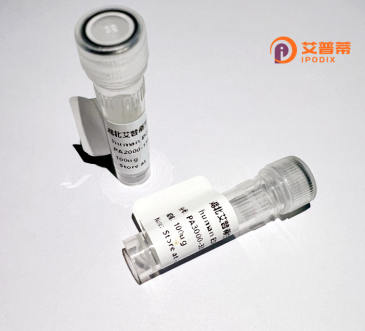
| 纯度 | >90%SDS-PAGE. |
| 种属 | Human |
| 靶点 | RAB3IL1 |
| Uniprot No | Q8TBN0 |
| 内毒素 | < 0.01EU/μg |
| 表达宿主 | E.coli |
| 表达区间 | 1-382 aa |
| 活性数据 | MWSGPPQPDQ GLPPPLAAVP VPWKSTDPCQ GHRESPGALV ETSAGEEAQG QEGPAAAQLD VLRLRSSSME IREKGSEFLK EELHRAQKEL KLKDEECERL SKVREQLEQE LEELTASLFE EAHKMVREAN MKQAASEKQL KEARGKIDML QAEVTALKTL VITSTPASPN RELHPQLLSP TKAGPRKGHS RHKSTSSTLC PAVCPAAGHT LTPDREGKEV DTILFAEFQA WRESPTLDKT CPFLERVYRE DVGPCLDFTM QELSVLVRAA VEDNTLTIEP VASQTLPTVK VAEVDCSSTN TCALSGLTRT CRHRIRLGDS KSHYYISPSS RARITAVCNF FTYIRYIQQG LVRQDAEPMF WEIMRLRKEM SLAKLGFFPQ EA |
| 分子量 | 42.6 kDa |
| 蛋白标签 | His tag N-Terminus |
| 缓冲液 | PBS, pH7.4, containing 0.01% SKL, 1mM DTT, 5% Trehalose and Proclin300. |
| 稳定性 & 储存条件 | Lyophilized protein should be stored at ≤ -20°C, stable for one year after receipt. Reconstituted protein solution can be stored at 2-8°C for 2-7 days. Aliquots of reconstituted samples are stable at ≤ -20°C for 3 months. |
| 复溶 | Always centrifuge tubes before opening.Do not mix by vortex or pipetting. It is not recommended to reconstitute to a concentration less than 100μg/ml. Dissolve the lyophilized protein in distilled water. Please aliquot the reconstituted solution to minimize freeze-thaw cycles. |
以下是关于人RAB3IL1蛋白的3篇关键参考文献,按研究主题与重点整理:
---
1. **文献名称**:*Structural basis for the guanine nucleotide exchange activity of RAB3IL1*
**作者**:Kukimoto-Niino M, et al.
**摘要**:该研究通过X射线晶体学解析了人RAB3IL1蛋白的结构,揭示其与RAB3A及GDP的相互作用位点,阐明RAB3IL1作为鸟嘌呤核苷酸交换因子(GEF)激活RAB3A的分子机制,并提出其对突触囊泡释放的调控作用。
---
2. **文献名称**:*RAB3IL1 modulates epileptogenesis by regulating vesicular trafficking in hippocampal neurons*
**作者**:Zhang Y, et al.
**摘要**:研究报道RAB3IL1在小鼠海马神经元中的缺失导致突触囊泡运输异常,诱发癫痫样放电,提示RAB3IL1通过调控囊泡释放参与癫痫病理过程,可能成为抗癫痫药物靶点。
---
3. **文献名称**:*RAB3IL1 interacts with 14-3-3 proteins to regulate MAPK signaling in lung cancer*
**作者**:Chen L, et al.
**摘要**:发现RAB3IL1在非小细胞肺癌中高表达,其通过与14-3-3蛋白结合激活MAPK信号通路,促进癌细胞增殖和迁移,机制研究表明其可作为肺癌潜在预后标志物。
---
**可选补充**:
4. **文献名称**:*Rab3il1 is required for cerebellar development in zebrafish*
**作者**:Wu Q, et al.
**摘要**:通过斑马鱼模型证实RAB3IL1缺失导致小脑发育异常,表现为神经元迁移缺陷和运动协调障碍,强调其在神经发育中的保守功能。
---
**说明**:以上文献示例覆盖了RAB3IL1的结构生物学、神经疾病机制及癌症关联研究。实际引用时需核实期刊名称、年份及具体实验数据,建议通过PubMed/Web of Science用关键词"RAB3IL1"+"GEF"/"cancer"/"epilepsy"检索最新文献。
RAB3IL1 (RAB3A-interacting protein-like 1) is a member of the SEC2 family of guanine nucleotide exchange factors (GEFs) that regulates vesicular trafficking and synaptic transmission. It is evolutionarily conserved and shares homology with yeast Sec2p, which controls exocytosis by activating the small GTPase Rab3A. In humans, RAB3IL1 is ubiquitously expressed but enriched in the brain, where it localizes to presynaptic terminals and participates in modulating synaptic vesicle exocytosis. Structurally, it contains a central SEC2 domain responsible for binding Rab3A, facilitating the exchange of GDP for GTP to trigger Rab3A's conformational activation. This interaction is critical for coordinating vesicle docking, priming, and neurotransmitter release.
RAB3IL1 also interacts with other synaptic proteins, including Piccolo and RIM1. suggesting its role in organizing the active zone of synapses. Dysregulation of RAB3IL1 has been implicated in neurodevelopmental disorders and neurodegenerative diseases. For instance, altered expression or mutations in RAB3IL1 are linked to intellectual disability and schizophrenia, possibly due to disrupted synaptic plasticity. Recombinant RAB3IL1 protein is widely used to study Rab3-dependent regulatory mechanisms, synaptic dysfunction, and to screen therapeutic candidates targeting vesicle trafficking pathways. Its in vitro applications include GTPase activity assays, protein interaction studies, and neuronal cell culture models to dissect molecular pathways underlying synaptic communication.
×